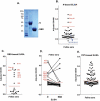Seroprevalence of SARS-CoV-2 (COVID-19) exposure in pet cats and dogs in Minnesota, USA
- PMID: 34125647
- PMCID: PMC8205054
- DOI: 10.1080/21505594.2021.1936433
Seroprevalence of SARS-CoV-2 (COVID-19) exposure in pet cats and dogs in Minnesota, USA
Abstract
The COVID-19 pandemic caused by the coronavirus SARS-CoV-2 is continuing to spread globally. SARS-CoV-2 infections of feline and canine species have also been reported. However, it is not entirely clear to what extent natural SARS-CoV-2 infection of pet dogs and cats is in households. We have developed enzyme-linked immunosorbent assays (ELISAs) using recombinant SARS-CoV-2 nucleocapsid (N) protein and the receptor-binding-domain (RBD) of the spike protein, and the SARS-CoV-2 spike-pseudotyped vesicular stomatitis virus (VSV)-based neutralization assay to screen serum samples of 239 pet cats and 510 pet dogs in Minnesota in the early phase of the COVID-19 pandemic from mid-April to early June 2020 for evidence of SARS-CoV-2 exposures. A cutoff value was used to identify the seropositive samples in each experiment. The average seroprevalence of N- and RBD-specific antibodies in pet cats were 8% and 3%, respectively. Among nineteen (19) N-seropositive cat sera, fifteen (15) exhibited neutralizing activity and seven (7) were also RBD-seropositive. The N-based ELISA is also specific and does not cross react with antigens of common feline coronaviruses. In contrast, SARS-CoV-2 antibodies were detected at a very low percentage in pet dogs (~ 1%) and were limited to IgG antibodies against SARS-CoV-2 N protein with no neutralizing activities. Our results demonstrate that SARS-CoV-2 seropositive rates are higher in pet cats than in pet dogs in MN early in the pandemic and that SARS-CoV-2 N-specific IgG antibodies can detect SARS-CoV-2 infections in companion animals with higher levels of specificity and sensitivity than RBD-specific IgG antibodies in ELISA-based assays.
Keywords: COVID-19; Elisa; SARS-CoV-2; cat; dog; feline coronaviruses; neutralization antibodies; seroprevalence; zoonoses.
Figures



Similar articles
-
Evaluation of a SARS-CoV-2 Capture IgM Antibody Assay in Convalescent Sera.Microbiol Spectr. 2021 Oct 31;9(2):e0045821. doi: 10.1128/Spectrum.00458-21. Epub 2021 Sep 8. Microbiol Spectr. 2021. PMID: 34494855 Free PMC article.
-
SARS-CoV-2 Antibody Testing in Health Care Workers: A Comparison of the Clinical Performance of Three Commercially Available Antibody Assays.Microbiol Spectr. 2021 Oct 31;9(2):e0039121. doi: 10.1128/Spectrum.00391-21. Epub 2021 Sep 29. Microbiol Spectr. 2021. PMID: 34585976 Free PMC article.
-
A Combination of N and S Antigens With IgA and IgG Measurement Strengthens the Accuracy of SARS-CoV-2 Serodiagnostics.J Infect Dis. 2021 Jul 15;224(2):218-228. doi: 10.1093/infdis/jiab222. J Infect Dis. 2021. PMID: 33905505 Free PMC article.
-
Understanding the prevalence of SARS-CoV-2 (COVID-19) exposure in companion, captive, wild, and farmed animals.Virulence. 2021 Dec;12(1):2777-2786. doi: 10.1080/21505594.2021.1996519. Virulence. 2021. PMID: 34696707 Free PMC article. Review.
-
Mind the feline coronavirus: Comparison with SARS-CoV-2.Gene. 2022 May 30;825:146443. doi: 10.1016/j.gene.2022.146443. Epub 2022 Mar 22. Gene. 2022. PMID: 35337854 Free PMC article. Review.
Cited by
-
The reverse zoonotic potential of SARS-CoV-2.Heliyon. 2024 Jun 13;10(12):e33040. doi: 10.1016/j.heliyon.2024.e33040. eCollection 2024 Jun 30. Heliyon. 2024. PMID: 38988520 Free PMC article. Review.
-
The potential risks posed by inter- and intraspecies transmissions of monkeypox virus.Virulence. 2022 Dec;13(1):1681-1683. doi: 10.1080/21505594.2022.2127199. Virulence. 2022. PMID: 36152027 Free PMC article. No abstract available.
-
Transmission of SARS-CoV-2 delta variant (AY.127) from pet hamsters to humans, leading to onward human-to-human transmission: a case study.Lancet. 2022 Mar 12;399(10329):1070-1078. doi: 10.1016/S0140-6736(22)00326-9. Lancet. 2022. PMID: 35279259 Free PMC article.
-
Prevalence of anti-severe acute respiratory syndrome coronavirus 2 antibodies in cats in Germany and other European countries in the early phase of the coronavirus disease-19 pandemic.Zoonoses Public Health. 2022 Aug;69(5):439-450. doi: 10.1111/zph.12932. Epub 2022 Mar 2. Zoonoses Public Health. 2022. PMID: 35238485 Free PMC article.
-
A one-year extensive molecular survey on SARS-CoV-2 in companion animals of Turkey shows a lack of evidence for viral circulation in pet dogs and cats.Vet Anim Sci. 2022 Dec 14;19:100280. doi: 10.1016/j.vas.2022.100280. eCollection 2023 Mar. Vet Anim Sci. 2022. PMID: 36582670 Free PMC article.
References
-
- Commissioner O of the. Coronavirus (COVID-19) . Update: FDA authorizes monoclonal antibodies for treatment of COVID-19 [Internet]. FDA2020 [cited 2021 January28]; Available from: https://www.fda.gov/news-events/press-announcements/coronavirus-covid-19...
-
- Commissioner O of the. COVID-19 . Vaccines. FDA; [Internet] 2021. [cited 2021 February27]; Available from: https://www.fda.gov/emergency-preparedness-and-response/coronavirus-dise...
Publication types
MeSH terms
Substances
LinkOut - more resources
Full Text Sources
Medical
Miscellaneous
